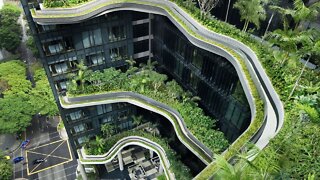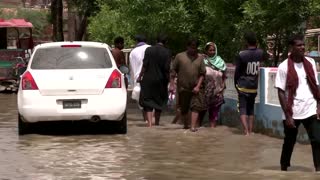Premium Only Content

How America's hottest city is trying to cool down
How America's hottest city is trying to cool down
Can trees help save Phoenix from extreme heat?
It’s time to stop looking at trees as a form of “beautification.” They are, instead, a living form of infrastructure, providing a variety of services that include stormwater management, air filtering, carbon sequestration, and, most importantly for a city like Phoenix, Arizona, they cool the environment around them.
Trees can lower neighborhood temperatures in three ways:
1) Their shade prevents solar radiation from hitting paved surfaces like concrete and asphalt, which absorb energy and rerelease it into the air as heat.
2) Their leaves pull heat from the immediate area in order to evapotranspirate water that’s drawn from the soil.
And, 3) If you’re standing under one, a tree protects your body directly from the sun’s rays. If you’ve ever made a summer visit to a dry, hot city like Phoenix, you’ll know how important shade is for making any outdoor experiences tolerable.
As Phoenix deals with a rising frequency of extreme heat waves — which aren’t only deadly, but also cause worrisome spikes in energy demand — the city is looking to trees as part of its heat mitigation strategy. Phoenix isn’t devoid of trees, but they’re distributed unevenly across the city. A quick glance at a satellite image of the metro area reveals substantial green splotches in the north and east and brown ones in the south and west, where many lower-income neighborhoods are located.
So Phoenix recently pledged to reach “tree equity” by 2030, under an agreement with American Forests, a national tree organization. I visited Phoenix recently to take a look at the current state of the city’s urban forest. In this video, we use drone imagery and thermal cameras to understand how the urban design of the city contributes to extreme heat, and what it can do to cool down.
-
 6:17
6:17
Newsy
3 years agoHow City Design Can Cool Down Your Neighborhood
61111 -
 0:16
0:16
Petra Genco Shorts
2 years ago $0.01 earnedTrying To Slim Down Your Legs?
11 -
 2:01
2:01
Reuters
2 years agoFurnace to flood: world's hottest city under water
542 -
 4:10
4:10
The Post Millennial Live
3 years agoChris Rufo tells Tucker Carlson how Disney is trying to groom America's children
2.01K8 -
 4:49:04
4:49:04
HogansAlleyHero
14 hours ago💥CHASING DOPAMINE💥✅TRUMP SAYS BATTLEFIELD IS THE BEST✅
12.9K -
 1:57:40
1:57:40
MattMorseTV
5 hours ago $6.62 earned🔴Trump just SHATTERED the PROJECTIONS.🔴
34.3K27 -
 2:32:19
2:32:19
megimu32
3 hours agoOTS: From Star Search to Superstardom
18.8K4 -
 1:56:21
1:56:21
Joker Effect
2 hours agoInterviewing GREENMAN! Looks like he is coming to Rumble! Let's give him a warm welcome! REAL TALENT
10.4K1 -
 1:07:21
1:07:21
Anthony Rogers
9 hours agoEpisode 380 - Is Pain All In Your Head?
7.35K2 -
 1:46:17
1:46:17
Glenn Greenwald
7 hours agoGlenn Takes Your Questions on Censorship, Epstein, and More; DNC Rejects Embargo of Weapons to Israel with Journalist Dave Weigel | SYSTEM UPDATE #505
106K6